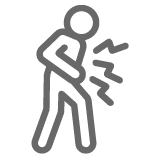2020 E. coli Outbreak Linked to Leafy Greens
Final Update

Posted on December 22, 2020 at 4:00 PM ET
This outbreak is over. Investigators have linked this outbreak to leafy greens, but a specific type or brand was not identified. You do not need to avoid eating leafy greens because of this outbreak. Learn more about how leafy greens can get contaminated and steps you can take to reduce your risk of getting sick from eating leafy greens.
CDC, public health and regulatory officials in several states, and the U.S. Food and Drug Administration (FDA) investigated several multistate outbreaks of E. coli O157:H7 infections. This outbreak is different from two other E. coli O157:H7 outbreaks that occurred at the same time (E. coli outbreak with unknown source 1 and E. coli outbreak with unknown source 3).

- Reported Cases: 40
- States: 19
- Hospitalizations: 20
- Deaths: 0
- Recall: No
- As of December 22, 2020, this outbreak is over.
- A total of 40 people infected with the outbreak strain of E. coli O157:H7 were reported from 19 states.
- Illnesses started on dates ranging from August 10, 2020, to October 31, 2020.
- 20 people were hospitalized, and 4 developed hemolytic uremic syndrome (HUS), a type of kidney failure. No deaths were reported.
- Epidemiologic and traceback evidence showed that leafy greens were the likely source of this outbreak. Investigators were unable to identify a specific type or brand of leafy greens because people in this outbreak reported eating a variety of leafy greens and because different leafy greens are often grown, harvested, and processed together.

Vegetables, including leafy greens, are an important part of a healthy, balanced diet. However, they can sometimes be contaminated with harmful germs.
The safest produce is cooked; the next safest is washed.
If you plan to eat your leafy greens raw:
- Wash your hands for 20 seconds with soap and water before and after preparing leafy greens.
- Discard outer leaves and any torn or bruised ones.
- Wash leafy greens if they are not labeled “ready to eat,” “triple washed,” or “no washing necessary.” Washing removes some germs and dirt, but it does not completely remove all germs.
- Rinse the leafy greens under running water and use your hands to gently rub the surface of the leaves. If you do not have access to safe tap water, rinse with other drinkable water (such as filtered, bottled, or distilled water).
- Don’t soak leafy greens in a sink or a bowl filled with water. They can get contaminated with germs in the sink and germs can spread from one leaf to the other leaves.
- Dry leafy greens with a clean cloth or paper towel.

- People usually get sick from Shiga toxin-producing E. coli (STEC) 2 to 8 days (average of 3 to 4 days) after swallowing the germ.
- Symptoms often include severe stomach cramps, diarrhea (often bloody), and vomiting. Some people may have a fever, which usually is not very high (less than 101˚F/38.5˚C).
- Some people with a STEC infection may get a type of kidney failure called hemolytic uremic syndrome (HUS).
- Antibiotics are not recommended for patients with suspected E. coli infections until diagnostic testing can be performed and E. coli infection is ruled out. Some studies have shown that administering antibiotics to patients with E. coli infections might increase their risk of developing HUS, and a benefit of treatment has not been clearly demonstrated.
- For more information, see Symptoms of E. coli Infection.
December 22, 2020
CDC, public health and regulatory officials in several states, and the U.S. Food and Drug Administration (FDA) investigated a multistate outbreak of E. coli O157:H7 infections linked to leafy greens.
Public health investigators used the PulseNet system to identify illnesses that may have been part of this outbreak. PulseNet is the national subtyping network of public health and food regulatory agency laboratories coordinated by CDC. DNA fingerprinting is performed on E. coli bacteria isolated from ill people by using a standardized laboratory and data analysis method called whole genome sequencing (WGS). CDC PulseNet manages a national database of these sequences that are used to identify possible outbreaks. WGS gives investigators detailed information about the bacteria causing illness. In this investigation, WGS showed that bacteria isolated from ill people were closely related genetically. This means that people in this outbreak were more likely to share a common source of infection.
As of December 18, 2020, a total of 40 people infected with the outbreak strain of E. coli O157:H7 were reported from 19 states. A list of the states and the number of cases in each can be found on the Map of Reported Cases page.
Illnesses started on dates ranging from August 10, 2020, to October 31, 2020. Ill people ranged in age from 1 to 85 years, with a median age of 33 years, and 60% were female. Of 34 ill people with information available, 20 people were hospitalized and 4 people developed hemolytic uremic syndrome (HUS), a type of kidney failure. No deaths were reported.
WGS analysis was conducted for isolates from 19 ill people; an isolate from 1 ill person was predicted to be resistant to ampicillin and amoxicillin-clavulanic acid, and 18 isolates from ill people were not predicted to be resistant to any antibiotics. Standard antibiotic susceptibility testing by CDC’s National Antimicrobial Resistance Monitoring System (NARMS) laboratory is currently underway. These findings do not affect treatment guidance since antibiotics are not recommended for patients with E. coli O157:H7 infections.
Investigation of the Outbreak
Epidemiologic and traceback evidence showed that leafy greens were the likely source of this outbreak. Investigators were unable to identify a specific type or brand of leafy greens because people in this outbreak reported eating a variety of leafy greens and because different leafy greens are often grown, harvested, and processed together.
State and local public health officials interviewed ill people to determine what they ate and other exposures in the week before they got sick. Of the 23 ill people interviewed, 22 reported eating or maybe eating a variety of leafy greens, including spinach (16) and romaine lettuce (15).
FDA completed traceback investigations for several types of leafy greens ill people reported eating. Several farms of interest were identified, but no single ranch was a common source of the leafy greens.
FDA and state partners conducted inspections on farms of interest and collected environmental samples. For more information, including the sampling results, visit the FDA outbreak webpage.
As of December 22, 2020, this outbreak is over.